
Syringa is a genus of 12 currently recognized species of flowering woody plants in the olive family or Oleaceae called lilacs. These lilacs are native to woodland and scrub from southeastern Europe to eastern Asia, and widely and commonly cultivated in temperate areas elsewhere.

Oleaceae, also known as the olive family or sometimes the lilac family, is a taxonomic family of flowering shrubs, trees, and a few lianas in the order Lamiales. It presently comprises 28 genera, one of which is recently extinct. The extant genera include Cartrema, which was resurrected in 2012. The number of species in the Oleaceae is variously estimated in a wide range around 700. The flowers are often numerous and highly odoriferous. The family has a subcosmopolitan distribution, ranging from the subarctic to the southernmost parts of Africa, Australia, and South America. Notable members include olive, ash, jasmine, and several popular ornamental plants including privet, forsythia, fringetrees, and lilac.

Dasiphora fruticosa is a species of hardy deciduous flowering shrub in the family Rosaceae, native to the cool temperate and subarctic regions of the northern hemisphere, often growing at high altitudes in mountains. Dasiphora fruticosa is still widely referenced in the horticultural literature under its synonym Potentilla fruticosa. Common names include shrubby cinquefoil, golden hardhack, bush cinquefoil, shrubby five-finger, widdy, kuril tea and tundra rose.

Camellia japonica, known as common camellia, or Japanese camellia, is a species of Camellia, a flowering plant genus in the family Theaceae. There are thousands of cultivars of C. japonica in cultivation, with many colors and forms of flowers. Despite its common name, it is native to China, not Japan. The cultivation of Camellia japonica also started in China. Its widespread cultivation can be traced back to the Song Dynasty, when 15 varieties of Camellia japonica were recorded in literature. It was later introduced to Japan. It grows in forests, at altitudes of around 300–1,100 metres (980–3,600 ft).

Weigela is a genus of between six and 38 species of deciduous shrubs in the family Caprifoliaceae, growing to 1–5 m (3–15′) tall. All are natives of eastern Asia. The genus is named after the German scientist Christian Ehrenfried Weigel.
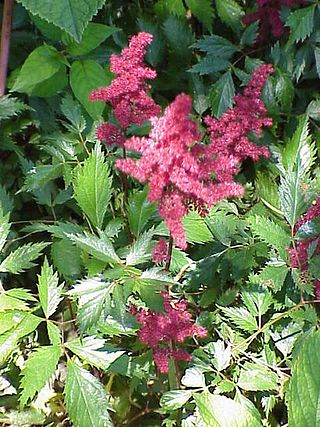
Astilbe is a genus of 18 species of rhizomatous flowering plants within the family Saxifragaceae, native to mountain ravines and woodlands in Asia and North America. Some species are known by the common names false goat's beard and false spirea.

Abeliophyllum, the miseonnamu, Korean abeliophyllum, white forsythia, or Korean abelialeaf, is a monotypic genus of flowering plants in the olive family, Oleaceae. It consists of one species, Abeliophyllum distichumNakai, endemic to Korea, where it is endangered in the wild, occurring at only seven sites. It is related to Forsythia, but differs in having white, not yellow, flowers.
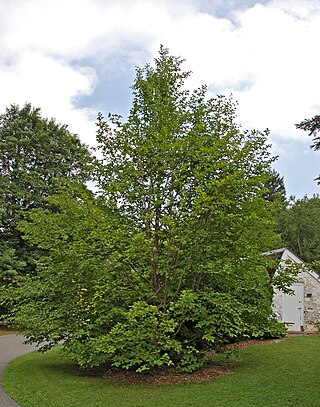
Stewartia pseudocamellia, also known as Korean stewartia, Japanese stewartia, or deciduous camellia, is a species of flowering plant in the family Theaceae, native to Japan and Korea.

Chaenomeles speciosa, the flowering quince, Chinese quince or Japanese quince, is a thorny deciduous or semi-evergreen shrub native to eastern Asia. It is taller than another commonly cultivated species, C. japonica, usually growing to about 2 m. The flowers are usually red, but may be white or pink. The fruit is a fragrant, hard pome that resembles a quince.

Anemone hepatica, the common hepatica, liverwort, liverleaf, kidneywort, or pennywort, is a species of flowering plant in the buttercup family Ranunculaceae, native to woodland in temperate regions of the Northern Hemisphere. This herbaceous perennial grows from a rhizome.
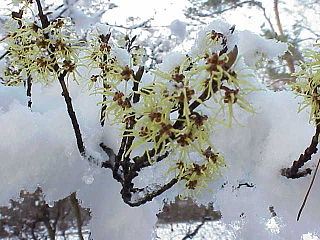
Hamamelis mollis, also known as Chinese witch hazel, is a species of flowering plant in the witch hazel family Hamamelidaceae, native to central and eastern China, in Anhui, Guangxi, Hubei, Hunan, Jiangxi, Sichuan, and Zhejiang.

Syringa reticulata, the Japanese tree lilac, is a species of flowering plant in the family Oleaceae native to eastern Asia, which is grown as an ornamental in Europe and North America.

Forsythia suspensa, commonly known as weeping forsythia or golden-bell, is a species of flowering plant in the family Oleaceae. It is native to China.
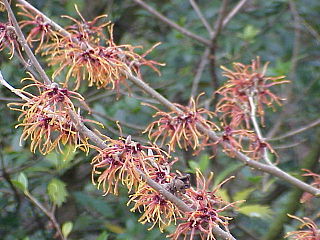
Hamamelis×intermedia, the hybrid witch hazel, is a flowering plant in the family Hamamelidaceae. It is a hybrid of garden origin between H. japonica and H. mollis. Its Latin name refers to its intermediate appearance between those two species.

Forsythia × intermedia, or border forsythia, is an ornamental deciduous shrub of garden origin.
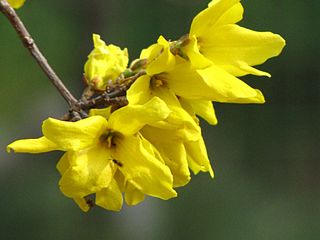
Forsythia koreana, commonly called gaenari (Hangul:개나리) or Korean goldenbell tree, is a species in the olive family, Oleaceae. It grows to about 3 m (9.8 ft). The leaves are oval in shape, have teeth, and are 3–12 cm (1.2–4.7 in) long. The front of the leaf is dark green and the back is dark blue, but both sides are hairless.
Veronica ovata is a species of flowering plant in the family Plantaginaceae. It is native to eastern Asia, including eastern China, Korea, and Japan.
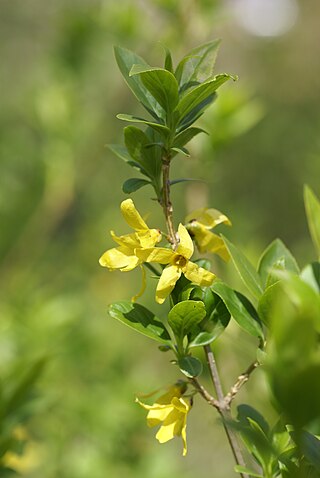
Forsythia viridissima, variously called the Chinese golden bell tree, green-stemmed forsythia, greenstem forsythia, and Korean forsythia, is a species of flowering plant in the genus Forsythia, native to southern China and South Korea, and introduced to Japan and the United States. It flowers about two weeks later than other forsythias. It may be of hybrid origin and is believed to be one of the parents of Forsythia × intermedia.

Forsythia europaea, commonly known as Albanian forsythia or European forsythia, is a species of flowering plant in the olive family, with a native range from Montenegro to northern Albania. It is the only species of Forsythia native to Europe; prior to its discovery in Albania in 1897, it was thought that all Forsythia were native to East Asia.

Forsythia ovata, the Korean forsythia or early forsythia, is a species of flowering plant in the family Oleaceae, native to the Korean Peninsula. An early bloomer, it is deer resistant, and hardy to −50 °F (−46 °C); USDA Hardiness zone 2a.































